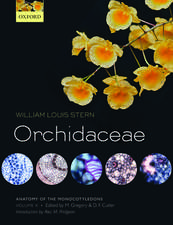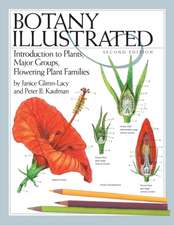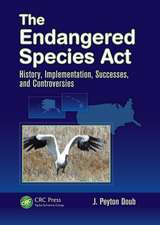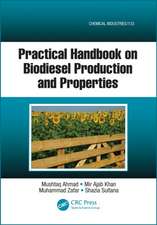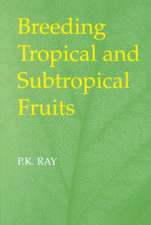Medicinal Plant Biodiversity of Lesser Himalayas-Pakistan
Autor Arshad Mehmood Abbasi, Mir Ajab Khan, Mushtaq Ahmad, Muhammad Zafaren Limba Engleză Hardback – 15 dec 2011
The utilization of medicinal plants in medicine suffers from the fact that although plants are used to treat diseases, scientific evidence is lacking in many cases. Different societies of the world use the plants according to their own beliefs and knowledge and previous experiences. Their knowledge about the use of the plants is usually not known to the other world or science. This book provides a brief introduction of Lesser Himalayas, ethnobotanical aspects, marketing and anthropogenic pressure on medicinal flora. It comprises one hundred medicinal plant species including Pteridophytes, Gymnosperms and Angiosperms (Monocots and Dicots) along with their scientific description and traditional uses.
| Toate formatele și edițiile | Preț | Express |
|---|---|---|
| Paperback (1) | 693.90 lei 6-8 săpt. | |
| Springer – 23 aug 2016 | 693.90 lei 6-8 săpt. | |
| Hardback (1) | 946.55 lei 6-8 săpt. | |
| Springer – 15 dec 2011 | 946.55 lei 6-8 săpt. |
Preț: 946.55 lei
Preț vechi: 1154.34 lei
-18% Nou
Puncte Express: 1420
Preț estimativ în valută:
181.11€ • 189.12$ • 149.56£
181.11€ • 189.12$ • 149.56£
Carte tipărită la comandă
Livrare economică 15-29 aprilie
Preluare comenzi: 021 569.72.76
Specificații
ISBN-13: 9781461415749
ISBN-10: 1461415748
Pagini: 236
Ilustrații: XIII, 220 p.
Dimensiuni: 155 x 235 x 17 mm
Greutate: 0.48 kg
Ediția:2012
Editura: Springer
Colecția Springer
Locul publicării:New York, NY, United States
ISBN-10: 1461415748
Pagini: 236
Ilustrații: XIII, 220 p.
Dimensiuni: 155 x 235 x 17 mm
Greutate: 0.48 kg
Ediția:2012
Editura: Springer
Colecția Springer
Locul publicării:New York, NY, United States
Public țintă
Professional/practitionerCuprins
Introduction : Lesser Himalayas – Pakistan & Medicinal Plant Wealth.- Ethnobotanical aspects.- Medicinal Plants Inventory.
Notă biografică
Arshad Mehmood Abbasi has obtained his M. Phil. in 2007 in Taxonomic and Ethnobotany of Medicinal Plants from Quaid-i-Azam University, Islamabad, Pakistan. He has published 13 research papers in national and international journals of repute. His research work concentrates on medicinal plants, ethnobotany, biodiversity, wild edible food resources (fruits and vegetables). Currently he is PhD scholar and Research Associate in the Department of Plant Sciences, Quaid-i-azam University, Islamabad, Pakistan.
Prof. Dr. Mir Ajab Khan has obtained Ph.D. in 1984 in Plant bio-systematics from Leicester University England. His research work has concentrated on Asteraceae, Poaceae, Rosaceae, Labiatae, Scrophulariaceae, Boraginaceae, Euphorbiaceae and Solanaceae of flowering plants. He has taught 32 Ph.D. and 75 M.Phil students in pure and applied disciplines of plant sciences. He has published seven books and 311 scientific papers in different national and foreign journals.
Dr. Mushtaq Ahmad obtained his Ph.D. in 2008 in plant taxonomy from Quaid-i-Azam University, Islamabad, Pakistan. He has published 135 research papers in national and international journals of repute. He is author of six books. His research work has concentrated on authentication of problematic medicinal plants, fingerprinting, SEM techniques, biodiversity and biofuel technology. He is an Assistant Professor in the Department of Plant Sciences, Quaid-i-Azam University, Islamabad, Pakistan.
Dr. Muhammad Zafar is herbarium botanist in the Department of Plant Sciences at Quaid-i-Azam University, Islamabad, Pakistan. He is author of three books. He has published 88 research papers in different national and international journals of repute. His research interests are medicinal plants and herbarium management.
Prof. Dr. Mir Ajab Khan has obtained Ph.D. in 1984 in Plant bio-systematics from Leicester University England. His research work has concentrated on Asteraceae, Poaceae, Rosaceae, Labiatae, Scrophulariaceae, Boraginaceae, Euphorbiaceae and Solanaceae of flowering plants. He has taught 32 Ph.D. and 75 M.Phil students in pure and applied disciplines of plant sciences. He has published seven books and 311 scientific papers in different national and foreign journals.
Dr. Mushtaq Ahmad obtained his Ph.D. in 2008 in plant taxonomy from Quaid-i-Azam University, Islamabad, Pakistan. He has published 135 research papers in national and international journals of repute. He is author of six books. His research work has concentrated on authentication of problematic medicinal plants, fingerprinting, SEM techniques, biodiversity and biofuel technology. He is an Assistant Professor in the Department of Plant Sciences, Quaid-i-Azam University, Islamabad, Pakistan.
Dr. Muhammad Zafar is herbarium botanist in the Department of Plant Sciences at Quaid-i-Azam University, Islamabad, Pakistan. He is author of three books. He has published 88 research papers in different national and international journals of repute. His research interests are medicinal plants and herbarium management.
Textul de pe ultima copertă
The Himalayan region is among the largest mountains systems of the world with uncounted unique medicinal plants resources. The lesser Himalayas ranges are the extension of Greater Himalayas. They have unique ecology, vegetation and diversity of medicinal flora due to tremendous variation in the altitude, climate and associated wildlife.
The utilization of medicinal plants in medicine suffers from the fact that although plants are used to treat diseases, scientific evidence is lacking in many cases. Different societies of the world use the plants according to their own beliefs and knowledge and previous experiences. Their knowledge about the use of the plants is usually not known to the other world or science. This book provides a brief introduction of Lesser Himalayas, ethnobotanical aspects, marketing and anthropogenic pressure on medicinal flora. It comprises one hundred medicinal plant species including Pteridophytes, Gymnosperms and Angiosperms (Monocots and Dicots) along with their scientific description and traditional uses.
Arshad Mehmood Abbasi has obtained his M. Phil. in 2007 in Taxonomic and Ethnobotany of Medicinal Plants from Quaid-i-Azam University, Islamabad, Pakistan. He has published 13 research papers in national and international journals of repute. His research work concentrates on medicinal plants, ethnobotany, biodiversity, wild edible food resources (fruits and vegetables). Currently he is PhD scholar and Research Associate in the Department of Plant Sciences, Quaid-i-azam University, Islamabad, Pakistan.
Prof. Dr. Mir Ajab Khan has obtained Ph.D. in 1984 in Plant bio-systematics from LeicesterUniversity England. His research work has concentrated on Asteraceae, Poaceae, Rosaceae, Labiatae, Scrophulariaceae, Boraginaceae, Euphorbiaceae and Solanaceae of flowering plants. He has taught 32 Ph.D. and 75 M.Phil students in pure and applied disciplines of plant sciences. He has published seven books and 311 scientific papers in different national and foreign journals.
Dr. Mushtaq Ahmad obtained his Ph.D. in 2008 in plant taxonomy from Quaid-i-Azam University, Islamabad, Pakistan. He has published 135 research papers in national and international journals of repute. He is author of six books. His research work has concentrated on authentication of problematic medicinal plants, fingerprinting, SEM techniques, biodiversity and biofuel technology. He is an Assistant Professor in the Department of Plant Sciences, Quaid-i-Azam University, Islamabad, Pakistan.
Dr. Muhammad Zafar is herbarium botanist in the Department of Plant Sciences at Quaid-i-Azam University, Islamabad, Pakistan. He is author of three books. He has published 88 research papers in different national and international journals of repute. His research interests are medicinal plants and herbarium management.
The utilization of medicinal plants in medicine suffers from the fact that although plants are used to treat diseases, scientific evidence is lacking in many cases. Different societies of the world use the plants according to their own beliefs and knowledge and previous experiences. Their knowledge about the use of the plants is usually not known to the other world or science. This book provides a brief introduction of Lesser Himalayas, ethnobotanical aspects, marketing and anthropogenic pressure on medicinal flora. It comprises one hundred medicinal plant species including Pteridophytes, Gymnosperms and Angiosperms (Monocots and Dicots) along with their scientific description and traditional uses.
Arshad Mehmood Abbasi has obtained his M. Phil. in 2007 in Taxonomic and Ethnobotany of Medicinal Plants from Quaid-i-Azam University, Islamabad, Pakistan. He has published 13 research papers in national and international journals of repute. His research work concentrates on medicinal plants, ethnobotany, biodiversity, wild edible food resources (fruits and vegetables). Currently he is PhD scholar and Research Associate in the Department of Plant Sciences, Quaid-i-azam University, Islamabad, Pakistan.
Prof. Dr. Mir Ajab Khan has obtained Ph.D. in 1984 in Plant bio-systematics from LeicesterUniversity England. His research work has concentrated on Asteraceae, Poaceae, Rosaceae, Labiatae, Scrophulariaceae, Boraginaceae, Euphorbiaceae and Solanaceae of flowering plants. He has taught 32 Ph.D. and 75 M.Phil students in pure and applied disciplines of plant sciences. He has published seven books and 311 scientific papers in different national and foreign journals.
Dr. Mushtaq Ahmad obtained his Ph.D. in 2008 in plant taxonomy from Quaid-i-Azam University, Islamabad, Pakistan. He has published 135 research papers in national and international journals of repute. He is author of six books. His research work has concentrated on authentication of problematic medicinal plants, fingerprinting, SEM techniques, biodiversity and biofuel technology. He is an Assistant Professor in the Department of Plant Sciences, Quaid-i-Azam University, Islamabad, Pakistan.
Dr. Muhammad Zafar is herbarium botanist in the Department of Plant Sciences at Quaid-i-Azam University, Islamabad, Pakistan. He is author of three books. He has published 88 research papers in different national and international journals of repute. His research interests are medicinal plants and herbarium management.
Caracteristici
Covers a topic of current interest in medicinal plants of the Lesser Himalayan region, a subject that will not go out of date for a long time Written by esteemed professionals in the field of plant sciences Provides new insights into the area of medicinal plant use Includes supplementary material: sn.pub/extras

